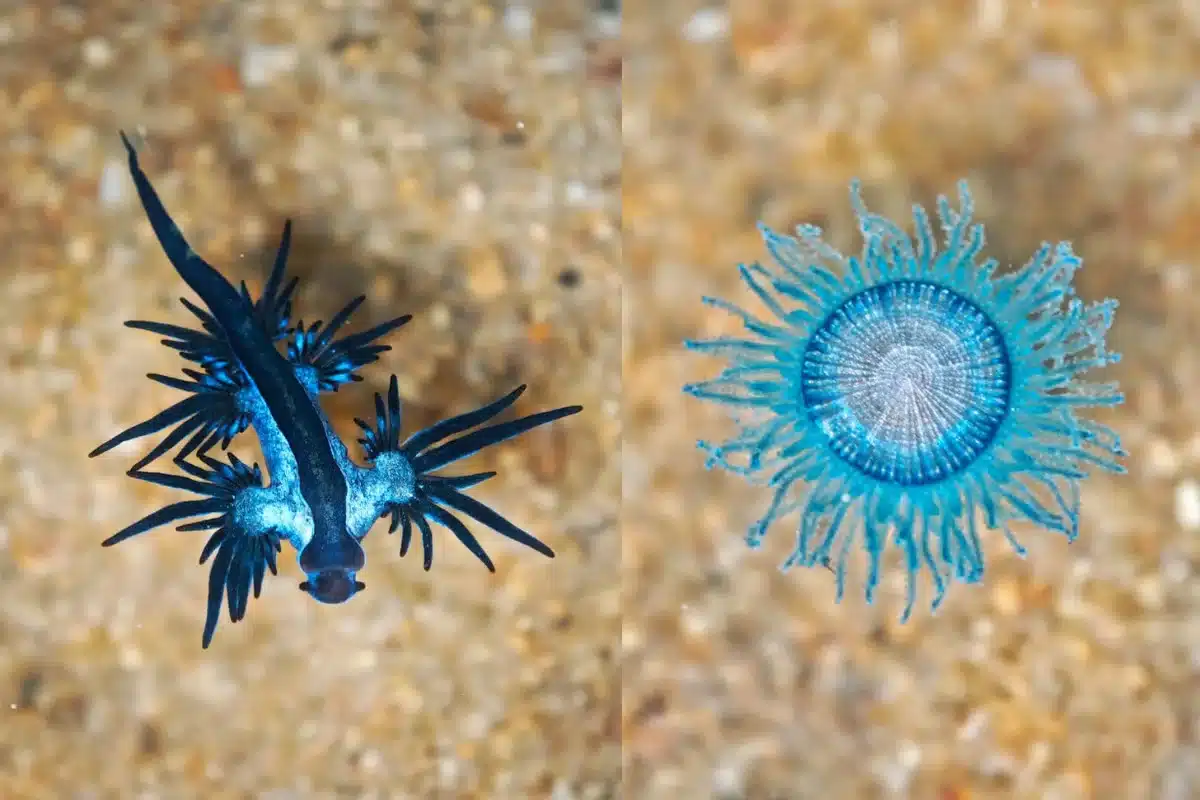Why in News?
- These deep-sea creatures could get pushed to shore sometimes due to a storm or some oceanic conditions.
- The recently-hit Cyclone Michaung would be the reason why Blue Sea Dragons and Blue Buttons were thrown off the Chennai coast.
About Blue Sea Dragon
- Also known as the blue angel and blue sea slug, the Blue Sea Dragon is a unique underwater creature that has the ability to camouflage.
- Scientific Name: Glaucus atlanticus
- It is a sea slug, a class of marine organisms that are shell-less molluscs with a wide range of colours and shapes.
- Distribution: Mostly found throughout the Atlantic, Pacific, and Indian Oceans in tropical and subtropical waters.
- Often spotted in deep oceans, Blue Sea Dragons would go in groups, which gave them the name ‘Blue Fleets’.
- It would store venom that it consumes from other creatures to inject venom on the foreign bodies they come into contact. But the venom isn’t lethal.
About Blue Button
- Blue Buttons, resembling button-like shapes, are not singular organisms but colonies of small predators called hydroids.
- These colonies float “passively” along the ocean, “performing specialised roles– stinging and preying, defending the colony from predators, and producing more of their kind.
- Scientific Name: Porpita porpita
- They are often confused with jellyfish.
- Distribution: Found in the tropical and subtropical waters of the Pacific, Atlantic, and Indian Oceans.
- Blue Button has a blue float made of a flat, circular disc with many gas-filled tubes that keep it afloat. The disc is surrounded by tiny blue tentacles.
- They have a ‘man of war’ mechanism, which means that they use the tentacles like body parts to sting any foreign body that comes into contact to defend themselves.
- Their venom isn’t lethal.
Q1) What is a jellyfish?
Jellyfish are invertebrates that, together with corals, gorgonians and anemones belong to a group called the cnidarians . This animal group has stinging cells which they use both to capture their prey and as a form of defense. Like all members of the phylum, the body parts of a jellyfish radiate from a central axis. Lacking brains, blood, or even hearts, jellyfish are pretty simple critters. They are composed of three layers: an outer layer, called the epidermis; a middle layer made of a thick, elastic, jelly-like substance called mesoglea; and an inner layer, called the gastrodermis.
Source: Venomous Blue Sea Dragon and Blue Button spotted on Chennai beach
Last updated on January, 2026
→ Check out the latest UPSC Syllabus 2026 here.
→ Join Vajiram & Ravi’s Interview Guidance Programme for expert help to crack your final UPSC stage.
→ UPSC Mains Result 2025 is now out.
→ UPSC Notification 2026 is scheduled to be released on January 14, 2026.
→ UPSC Calendar 2026 has been released.
→ UPSC Prelims 2026 will be conducted on 24th May, 2026 & UPSC Mains 2026 will be conducted on 21st August 2026.
→ The UPSC Selection Process is of 3 stages-Prelims, Mains and Interview.
→ Prepare effectively with Vajiram & Ravi’s UPSC Prelims Test Series 2026 featuring full-length mock tests, detailed solutions, and performance analysis.
→ Enroll in Vajiram & Ravi’s UPSC Mains Test Series 2026 for structured answer writing practice, expert evaluation, and exam-oriented feedback.
→ Join Vajiram & Ravi’s Best UPSC Mentorship Program for personalized guidance, strategy planning, and one-to-one support from experienced mentors.
→ UPSC Result 2024 is released with latest UPSC Marksheet 2024. Check Now!
→ UPSC Toppers List 2024 is released now. Shakti Dubey is UPSC AIR 1 2024 Topper.
→ Also check Best UPSC Coaching in India

















